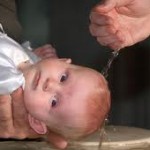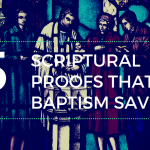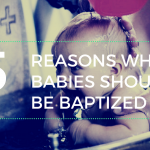It is a common aspect of Reformed sacramental theology that a parallel is made between the Old Testament rite of circumcision, and the New Testament sacrament of baptism. This connection is foundational for the baptismal theology of Ulrich Zwingli and the consequent reformed tradition. It is noteworthy, however, that such a strong connection does not appear in any significant sense in the church fathers. One might wonder then exactly why such a parallel became so prominent. It appears that the purpose for this is to make an argument for infant baptism which does not rely on a conviction of baptismal regeneration which stood behind all previous defenses of paedobaptism. The result is that baptism is viewed by many as a replacement for circumcision. This then is used to draw several conclusions about the sacrament, as circumcision then becomes determinative of the nature of its replacement in the new covenant.
It is not to be denied that there is some parallel between circumcision and baptism, as St. Paul makes such a connection in Colossians 2:11, wherein the sacrament is labelled, “the circumcision of Christ.” However, this is far from the most prominent typological picture of baptism that appears in the New Testament. This reference remains short, and it does not appear to impact the theology of Paul or the other Apostles in any particularly significant manner. Had the apostles’ doctrine of baptism been tied so strongly to circumcision, such a connection would surely have been noted at the council of Jerusalem in Acts 15, or in Paul’s discussion of the necessity of circumcision in Galatians. Would not this idea have solved the issue altogether? Could Paul have not just said, “we know that circumcision had been replaced by baptism, making circumcision no longer necessary,” and left it at that? However, such an argument is not made.
There are several types of baptism referenced by the New Testament authors, and there is no reason why this particular parallel should receive more attention than the others. A more extensive connection is made by Peter in 1 Peter 3:21, where the Noahic flood is called a “type” of baptism. This connection is a much more obvious one, especially related to the fact that both water and salvation are involved. Note that the entire parallel rests on the fact that Noah and his family were physically saved from God’s wrath through God’s provision in the flood (1 Peter 3:20). There was no mere symbolic act going on in the flood! I wonder whether the realism of salvation in such a parallel is the reason why this type receives significantly less attention than circumcision.
Another type used by Paul is that of the crossing of the Red Sea. According to the apostle, when the Israelites walked on dry land through the water, they were “baptized into Moses” (1 Cor. 10:2). Again, the parallel between this and baptism is twofold: the use of water, and salvation. There is no symbolic deliverance here, but the Israelites were literally redeemed from their Egyptian captors by way of water. It is also worth noting that this is a clear example of infants receiving baptism, as there certainly were babies among the Israelites. This, according to Paul, also connects to baptism in that the crossing of the Red Sea led to a later communal eating and drinking wherein the people partook of Christ (1 Cor. 10:3-4). It is a consistent theme throughout the Old Testament that cleansing with water is a necessity prior to receiving a meal, such as with the priestly washings necessary prior to a sacrifice which was then eaten. The parallels between this and the New Testament sacraments could not be more clear.
Along with these two salvific events which involve water in the Old Testament, the Mosaic Law included several water rites which could be described as baptisms. The author of Hebrews uses language of “baptisms” (plural) as a means to exposit various ritual washings (Heb. 6:2). Such language of ceremonial washing also occurs in 10:22 which language of both sprinkling and washing. There are washings described throughout the Torah, and especially in the book of Leviticus. These sprinklings are generally for two purposes. First, there is a washing which occurs for the priests, connected to both their ordination and their individual acts of sacrifice. A washing makes one worthy to enter into the temple and stand within God’s presence. The concepts of priesthood and washing are intimately connected, which is why the book of 1 Peter speaks extensively both about universal priesthood and baptism in the new covenant. The second group of washings are for those who are ceremonially unclean. If one was unclean, they were cut off from the worshipping assembly, and could not be present at the feasts of Israel. Again, washing is not a mere symbol but is necessary for one to enter into the community, as well as to partake of the meals.
For the New Testament authors, baptism is not an incidental teaching, nor is it limited in its application to its connection with circumcision. Baptism is no mere sign of the covenant or symbolic action. Instead, it is connected to acts of actual redemption, and the ability to stand in God’s presence despite one’s sin and natural uncleanness. Let’s not limit our proclamation, but preach the fullness of God’s salvation as delivered in the sacrament of baptism.












